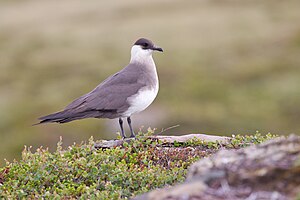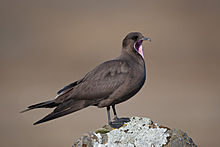Arctic sku
| Arctic sku | ||||||||||||
|---|---|---|---|---|---|---|---|---|---|---|---|---|

Arctic Skua ( Stercorarius parasiticus ) |
||||||||||||
| Systematics | ||||||||||||
|
||||||||||||
| Scientific name | ||||||||||||
| Stercorarius parasiticus | ||||||||||||
| ( Linnaeus , 1758) |
The Arctic Skua ( Stercorarius parasiticus ) is a sea bird in the Stercorariidae family . The zirkumpolar breeding in the tundra and coastal swamps Eurasian and North American type is among the skuas the most common type, which in Central Europe during the migration periods can be observed on the coasts.
description

It has a length of 44 to 55 cm, excluding the elongated tail feathers, which protrude 7 to 10 cm in summer. The plumage is brown on the back and ash gray or white below with a yellowish tinge on the neck. The wings and tail are black on the outside and lighter on the inside. The wings still have lightning-shaped white marking. The beak is bluish at the base and black at the tip. There are also seasonal changes.
Distribution and way of life
The breeding areas of the Arctic Skua are in northern Eurasia and North America . In Europe, the southernmost occurrences are in Scotland . The nests are located in a depression on the dry tundra or on ridges or on islands. Sometimes abandoned seagull nests are also used. The female lays 4 eggs, which she protects with great effort. Like other skuas, it starts attacks on the heads of people who come too close to the nest. The injuries sustained in such an attack are not overly dangerous, but it is a rather unpleasant experience.
The flight is similar to that of a falcon with slow gliding phases, which are abruptly interrupted by lightning-fast dive flights or ascent. Arctic skuas hunt lemmings or other rodents in the breeding area. Often they also rob seagulls or terns of their prey.
Inventory forecast
The Arctic Skua is considered to be one of the species that will be particularly hard hit by climate change. A research team that, on behalf of the British Environmental Protection Agency and the Royal Society for the Protection of Birds, examined the future development of the distribution of European breeding birds on the basis of climate models, assumes that by the end of the 21st century the range of the parasitic seagulls will shrink considerably will move north. Scotland, the south of Norway and most of the Baltic coasts will then no longer be able to offer suitable habitats for the species.
literature
- Hans-Günther Bauer, Einhard Bezzel and Wolfgang Fiedler (eds.): The compendium of birds in Central Europe: Everything about biology, endangerment and protection. Volume 1: Nonpasseriformes - non-sparrow birds. Aula-Verlag Wiebelsheim, Wiesbaden 2005, ISBN 3-89104-647-2 .
Web links
- Stercorarius parasiticus in the endangered Red List species the IUCN 2008. Posted by: BirdLife International, 2008. Accessed January 31 of 2009.
- Videos, photos and sound recordings of Stercorarius parasiticus in the Internet Bird Collection
- Photos at www.naturlichter.de
- Video: Heinz Sielmann: Stercorarius parasiticus (Stercorariidae) - entice . Institute for Scientific Film (IWF) 1978, made available by the Technical Information Library (TIB), doi : 10.3203 / IWF / E-1473 .
Single receipts
- ↑ Bauer et al., P. 551
- ^ Brian Huntley, Rhys E. Green, Yvonne C. Collingham, Stephen G. Willis: A Climatic Atlas of European Breeding Birds , Durham University, The RSPB and Lynx Editions, Barcelona 2007, ISBN 978-84-96553-14-9 , P. 207



